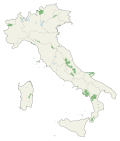You can help expand this article with text translated from the corresponding article in Italian. Click [show] for important translation instructions.
|
This article includes a list of references, related reading, or external links, but its sources remain unclear because it lacks inline citations .(June 2025) |
| Parco Nazionale Appennino Tosco-Emiliano | |
|---|---|
 Monte Prado in the park in winter | |
| Location | Emilia-Romagna, Toscana |
| Nearest city | La Spezia |
| Coordinates | 44°19′06″N10°14′26″E / 44.31833°N 10.24056°E |
| Area | 227.92 km2 (88.00 sq mi) |
| Established | 2001 |
| Governing body | Ministero dell'Ambiente |
| www | |

Appennino Tosco-Emiliano National Park is a state-held natural preserve in Northern and central Italy, located in the heart of an area noted for natural features and for the local quality products and handicrafts. It was founded in 2001, and is included in the provinces of Massa and Carrara, Lucca, Reggio Emilia and Parma.

